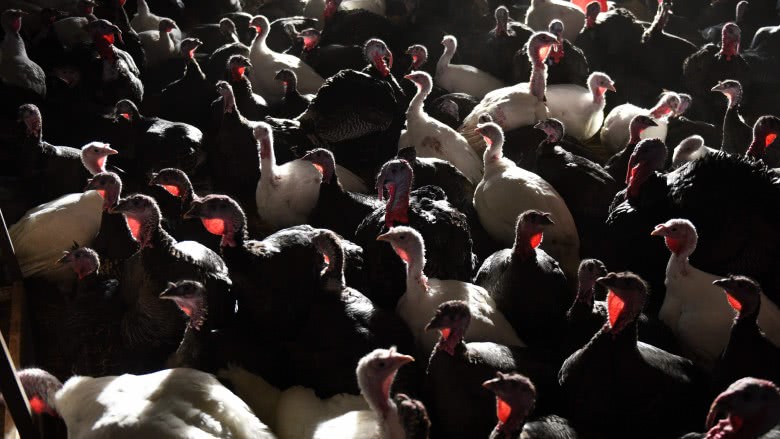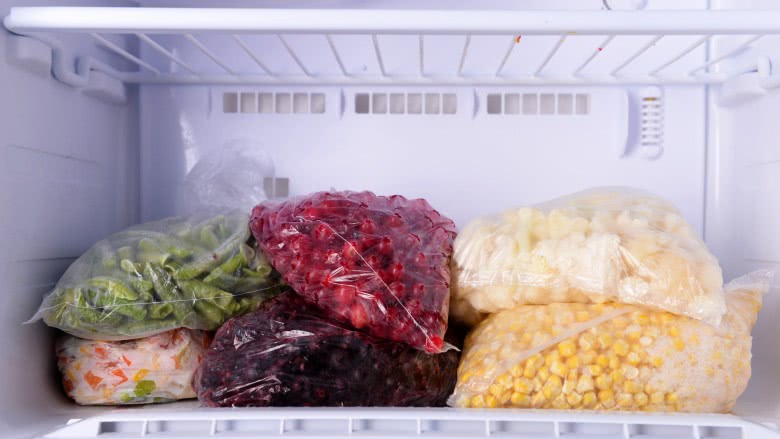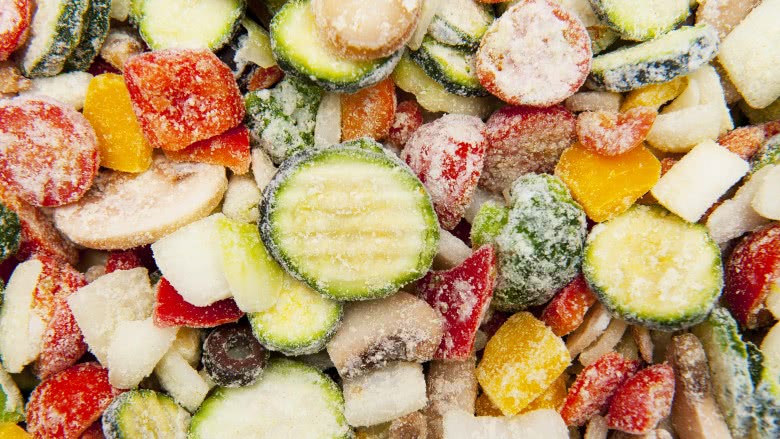Everything You Need To Know About Frozen Dinners
Like them or hate them, frozen dinners are a staple food in many American households. From low-cost budget entrees to higher-end organic dinners, there are entire aisles in grocery stores fully stocked with pre-made, frozen meals. And while some have evolved far beyond their humble protein-and-potato origins, others have remained true to classic form.
With such a variety of meals and a diverse array of consumers, there's a lot to learn about these technologically enabled foods. Here's a list of everything you need to know about the myriad of frozen dinners out there.
It started with turkeys
The ingredient that spurred the invention of the TV dinner was turkey — 520,000 pounds of turkey, to be exact.
In the early 1950s, the Swanson brothers presented their staff with a task: what should they do with the enormous surplus poultry leftover from a less-than-stellar Thanksgiving sales season? Enter salesman Gerry Thomas. Inspired by airline meals and his time in the service using mess kits, Thomas proposed they package the turkey prepared with side dishes and frozen in a compartmentalized tray.
The other inspiration? Television. Although television had been invented back in the 1920s, they were not widely present in home until the 1950s. According to professor Mitchell Stevens, "The number of television sets in use rose from 6,000 in 1946 to some 12 million by 1951. No new invention entered American homes faster than black and white television sets; by 1955 half of all U.S. homes had one."
Thomas proposed that the frozen, packed meal be served in a television-themed box, capitalizing on the booming market trend. So while the TV dinner was not the first frozen food to appear on American shelves, it was definitely the one that brought these meals into millions of American homes.
But don't forget Birds Eye
While Swanson was the company to launch frozen dinners into life as a household item, they wouldn't have been able to without the techniques first introduced to the American marketplace by Clarence Birdseye, founder of Birds Eye. It sounds like a work of fiction, but it's true: Birdseye learned about flash freezing while traveling when he saw the indigenous people of the Arctic, who utilized their environment to instantly freeze fresh fish.
Once back home in the states (and thanks to some well-off investors), Birdseye was able to develop technology not only to flash freeze vegetables on a mass scale, but also to build commercial display freezers. All of this provided both the technology and the infrastructure necessary to distribute millions of TV dinners to Americans.
So it was the cheeky and innovative marketing of Thomas that made frozen dinners a staple of our lives. But had freezing not been an option, the TV dinner would not have been born, so we owe Birdseye a thank you.
They empowered women
It might seem strange that a frozen meal could empower women, but that's exactly what the TV dinner did. In the 1950s, women were expected to be wives, mothers, and homemakers, and cooking for the family was one of the most important things a woman was expected to do. But with the debut and success of frozen dinners, women were now free to commit the time spent cooking into other forms of personal development. This was undoubtedly a win for female autonomy.
This trend did not evolve in a vacuum, either. During World War II, women were called into factories to aid in the war effort. For many women, this was the first time they were out of the home and in the workforce, a huge change from cooking, cleaning, and child rearing. So during this time, women developed a hunger for independence. Frozen dinners were just one more way to get it.
But not everyone was happy about this trend. Swanson received hate mail regarding the TV dinner, mostly from husbands who were angry their wives weren't preparing home-cooked dinners anymore. Complain as they might, though, there was no stopping the frozen food train from giving women some newfound freedom.
They're cost-effective
Convenience is not the only reason people are buying frozen dinners, according to one study. Parents, arguably one of the busiest consumer demographics, are also buying frozen meals for a myriad of reasons: because their families enjoys the meals, their kids can help prepare them, and they saw cost savings when they looked at money spent on conventional food.
Cost-savings is a huge advantage, especially for lower-income families; they can access the same foods as wealthier families when purchasing these foods in the form of frozen dinners. Certified nutritionist Michael Joseph agrees, noting, "The price of frozen food makes it more accessible to everyone. It is okay to preach that we must eat single ingredient, fresh foods, but this doesn't take expense into account and many people simply cannot afford the foods we view as the healthiest."
Add the money saved to the time saved, and you can see why frozen dinners are super appealing.
Benefits for the elderly and infirm
Aside from convenience and savings, frozen dinners can be a great way to feed the sick and the elderly. Registered dietitian Liz Blom told me, "Frozen dinners in a scenario where you have an individual living alone may be literally life nourishing. With so many choices available in the arena of frozen meals, a person can take some guesswork out of what they are taking in or feeding a loved one." Another advantage, Blom says, is being able to use labels as a means to getting adequate nutrition. "The label will not only reveal sodium, but will also provide the core nutrition including calories, carbohydrates protein and fat content."
Finally, if you're concerned about satisfaction, you might not have to stress. Blom says, "Worried about the monotony? It may not be worth the extra stress. According to a small study published in 2000, researchers found that older adults reported significantly fewer food cravings than the young adults." So frozen dinners can be a magic bullet for those who need special nutrition.
Frozen is fine
A lot of prepared, pre-packaged foods are loaded with preservatives to keep the food fresh and safe to eat. But one good thing about frozen dinners is that they don't need preservatives to keep them fresh. Dietitian Andy De Santis tells me, "Freezing is an exceptional means of storing food and preserving all types of food. Meals, including frozen meals, that are properly sealed and frozen (and that remain frozen) can be preserved for multiple months without concern." That means these meals will last for a long time in your freezer, which is great for reducing waste and having healthy food on hand.
And the quality of the food can be good in frozen dinners, sometimes better than so-called "fresh" foods. Nutritionist Michael Joseph notes, "The food in frozen dinners is not inherently different to real, fresh food. The process of freezing food has no real negative effect and it can often better preserve essential vitamins and minerals." So freezing itself is the only necessary (and natural) preservative.
The downside
Although frozen dinners are not inherently "bad" across the board, when you give up control of what you're eating, there are consequences. Dietitian Rebecca Lewis notes, "Since you didn't prepare these frozen meals yourself, you have no control over how much fat, sodium, and sugar was put into the meal. Moreover, frozen foods have a tendency of appealing to our desire for comfort foods. This means they often consist of meat & potatoes, pizza, and sauce-heavy dishes." That might not bode well for your waistline.
Nutritionist Michael Joseph observes another problem: the presence of trans fats in frozen dinners. He says, "Unfortunately, despite the ban on trans fats scheduled for 2018, there are still an uncomfortable amount of packaged foods that contain this harmful ingredient. And what's more, food producers often call their product 'trans fat free' even though it contains the deadly fats." And while this is alarming, it's not illegal. Joseph notes, "There is a legal loophole which allows them to get away with this. For instance, if there is less than 0.5g trans fat per serving, then they are legally allowed to declare the product free of trans fat. Ever wondered why serving sizes look ridiculously small and unrealistic for some processed foods? Then this could well be the reason why."
Good for dieters?
For many folks, relying on diet-friendly frozen meals is an easy way to monitor intake of fat and calories. These meals can help you with portion control as well.
But registered dietitian Karen Collins notes there are other potential issues with these meals. She said (via NBC News), "When the frozen meals are not available, people go back to their old habits because they haven't learned how to make other healthful choices that fit their lifestyle." There's also potentially too few calories in your meal. "Some people look for meals as low in fat and calories as possible. Products that flaunt content 'less than 300 calories' may actually be too low in calories for many people." And according to Collins, this can lead to a lowered metabolic rate or snacking that's not mindful.
So relying on frozen dinners as a healthy diet practice, while helpful in some ways, is not a long-term or sustainable solution.
They've diversified
If you've browsed the frozen food aisle (or aisles!) at your local grocery regularly, you've probably noticed there's a much bigger selection than there used to be. That's because more and more companies are getting in on the frozen food game. According to The Sage Encyclopedia of Food Issues, "The variety of frozen foods is ever-increasing with products catering to all tastes, dietary requirements, and occasions. Increasingly, product lines are being diversified to include upmarket items as well." And the possibilities are seemingly endless.
So along with more simple, staple frozen dinners (think baked chicken, spaghetti, or turkey dinners) you can now find more nuanced offerings, including organic, vegetarian, gluten-free, non-GMO, and plant-based meals. And there are more dinners showing up on shelves with each new food trend as its consumer-driven. So no matter what your dietary needs are, there's something frozen for everyone.









